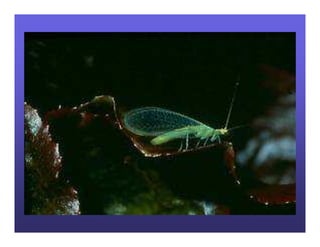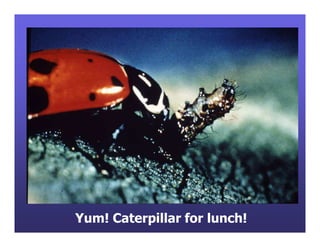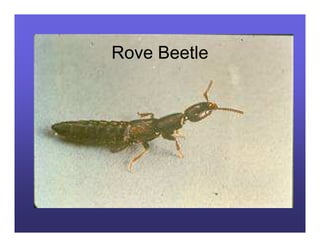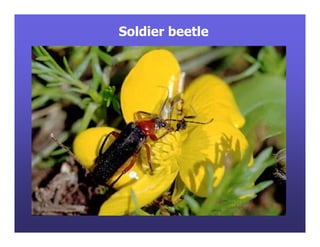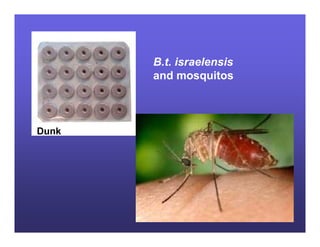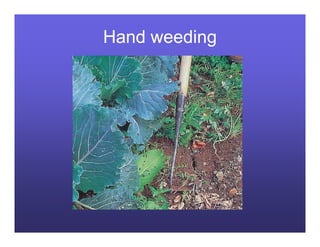Integrated Pest Management
- 1. Integrated Pest Management Jan McNeilan Gail Gredler OSU Master Gardener™ Program
- 2. Integrated Pest Management • A strategy to prevent and suppress pests with minimum impact on human health, the environment and non-target organisms. • Decision-making process that uses regular monitoring to decide if and when treatments are needed to control a pest, then uses a variety of tactics to keep pest numbers low.
- 3. Principles of Integrated Pest Management • Monitor the plants • Identify the pest organism • Establish an acceptable injury level • Manage using all available strategies
- 4. Monitor plants • Look for damage on a regular basis – Different times of the day – Tools: hand lens, traps, beat sheets – Collect samples of damage • Keep a record of your observations
- 5. Identify the pest organism • Is it a pest problem or a problem caused by a non-living factor (drought, frost, chemical damage, etc.)? • Is the pest an insect, disease, weed, etc.?
- 6. Know the pest Once the pest is identified, learn about its life cycle and its natural enemies. Root weevil larva Root weevil pupa Root weevil adult
- 7. Learn the pest’s life cycle
- 8. Establish an acceptable injury level Commercial example: Action threshold for strawberry root weevil in mint = .92 weevil larvae/square foot
- 9. Acceptable Injury Level For gardeners, this will differ between individuals.
- 10. Manage using all available strategies • Cultural • Physical • Biological • Chemical – Use the easiest, least expensive, least disruptive and least toxic ones first
- 11. Cultural Methods of Insect Control Sound gardening practices
- 13. Crop rotation
- 14. Companion planting: establishment of two or more plant species in close proximity so that some benefit is derived • Trap cropping • Biochemical pest suppression • Spatial interactions • Beneficial habitats • Security through diversity
- 15. Intercropping with insectary plants
- 16. Encourage ecological diversity in the garden
- 18. Sanitation
- 19. Physical Methods of Insect Control Barriers: Row Covers Cabbage maggot Flea beetle
- 21. Barriers: Sticky barrier Root weevils Ants tending aphids
- 22. Barriers: Copper barrier Brown Garden Snail
- 23. Barriers: Plant cages and collars
- 24. Handpicking
- 25. Watering Aphids Spider mites
- 26. Pruning Tent caterpillars
- 27. Trapping Yellow sticky trap Trapping for fungus gnats
- 28. Trapping Apple maggot trap Codling moth pheromone trap
- 29. Trapping Slugs and Snails
- 31. Vacuuming Boxelder Bug Flea
- 32. Garden symphylan Tilling
- 33. Biological Methods of Insect Control Beneficial Organisms – Pollinators – Predators – Parasitoids – Microbials • Bt • Beneficial nematodes
- 35. Bumblebee
- 36. Bumblebee
- 43. Predators
- 45. Yellow Jacket
- 48. Praying mantis
- 50. Green lacewing eggs Green lacewing larva dining on a caterpillar
- 55. Snakefly
- 61. Minute Pirate Bug Nymph
- 62. Big-eyed Bug
- 63. Assassin bug
- 65. Damsel Bug and Nymph
- 67. Ambush Bug
- 75. Yum! Caterpillar for lunch!
- 78. Ground beetle
- 80. Rove Beetle
- 82. Soldier beetle
- 85. Yellow Violet-green Warblers swallow
- 86. Domestic Ducks
- 87. All bat species in Oregon are insectivores
- 88. Common Garter Snake Toad © David Rosen Pacific Chorus Frog © David Rosen
- 89. Spiders
- 90. Garden Centipede
- 92. Millipede
- 93. Parasitoids
- 94. Braconid Wasp
- 95. Parasitoid wasp laying eggs in aphid
- 96. Aphid mummies
- 97. Tachinid fly
- 98. Tachinid fly and elm leaf beetle larvae
- 100. Trichogramma laying eggs in caterpillar eggs Trichogramma adults emerging from caterpillar eggs
- 101. Many insects in the soil are beneficial
- 102. Springtail Oribatid mites
- 103. Purchasing and Releasing Beneficials
- 104. Enhancing habitat for beneficials • Provide diversity of plants • Provide insectary plants with small flowers • Provide adequate water
- 105. Fennel Buckwheat Fiddleneck (Phacelia)
- 108. B.t. israelensis and mosquitos Dunk
- 110. B.t. san diego and elm leaf beetle
- 111. Beneficial nematodes
- 112. Infected root weevil pupa Infected root weevil adult
- 113. Horsehair Worm
- 114. •Very low mammalian toxicity • Soil must remain moist • Soil must be greater than 55 degrees F.
- 115. Chemical Methods of Insect Control: Botanicals • Derived from botanical sources • Biodegrade rapidly • Widely varying levels of toxicity
- 116. Botanical insecticide: Neem • From seeds of the neem tree • Broad spectrum against many pests • Must be ingested to be toxic • Low mammalian toxicity • May require repeat applications
- 117. Horticultural Oil • Derived from petroleum, vegetable or fish oil • Smothers insects and mites • Works best on soft-bodied insects • Low mammalian toxicity • Avoid hottest part of day • Avoid drought-stressed plants • Use commercial products rather than homemade
- 118. Insecticidal Soap • Contact insecticide smothers and desiccates insect • Use against soft-bodied insects like aphids, thrips, whitefly, and mites • Low mammalian toxicity • Requires excellent coverage, repeat applications • Biodegrades rapidly • Effective only until it dries
- 119. You cannot recommend homemade solutions!
- 120. Sulfur • Use dust mask with dust product • Broad spectrum miticide and fungicide • Low mammalian toxicity • Do not use within two weeks of an oil spray • Some plants sensitive to sulfur
- 121. Pheromones • Used for mating disruption • Useful for codling moth management in orchards • Limited usefulness in backyards
- 122. Synthetic Insecticides • Fewer available all the time • Widely varying toxicity • Always read and follow label directions • Dispose of properly
- 123. Other options: Kaolin clay • Naturally occurring mineral • Film acts as a barrier between pest and fruit • Irritates and repels insect feeding and egg- laying
- 125. Disease Management
- 126. Right plant, right place Choose plants well adapted to site
- 127. Rotate annuals
- 128. Select resistant varieties ‘Liberty’: Scab resistant ‘Gravenstein’: Not scab resistant
- 129. Use disease-free plants and disease- seeds
- 130. Irrigate properly
- 131. Plant properly
- 132. Fertilize as needed
- 133. Don’t crowd plants
- 134. Control insects and weeds • Insects can vector diseases such as plant viruses • Weeds can harbor diseases that can be detrimental to desirable plants
- 135. Sanitation Remove diseased plants and plant parts
- 136. Dispose of crop refuse/compost
- 137. Sanitation Prune out diseased wood
- 138. Use mulches
- 139. Make and use compost
- 140. Use fungicides when necessary • Copper • Lime sulfur • Sulfur • Horticultural oil • Potassium bicarbonate • Neem oil
- 141. Weed Management In Oregon, weeds grow like….well, weeds.
- 142. Mulching
- 143. Mulches • Barkdust • Wood chips • Gravel or rock • Cocoa or filbert shells • Sawdust • Newspaper or horticultural paper • Woven fabrics • Plastic
- 144. Hand weeding
- 145. Machine weeding
- 146. Spacing
- 147. Solarization
- 148. Cover cropping
- 149. Barriers
- 150. Herbicides • Conventional herbicides • Herbicidal soap • Vinegar • Corn gluten meal
- 151. Biological control Tansy flea beetle Cinnabar moth larvae feeding on tansy ragwort
- 152. Avoid invasive plants Butterfly bush English ivy Wild Clematis
- 153. Principles of Integrated Pest Management - Review • Monitor the plants • Identify the pest organism • Establish an acceptable injury level • Manage using all available strategies
- 154. Choose a Treatment Strategy • Use easiest, least disruptive, least expensive, least toxic first • Read the label, read the label, read the label • If you decide to use any kind of an pesticide, spot treat only and wear protective clothing when applying
- 155. Our IPM Mission • Oregon State University Extension Service encourages sustainable gardening practices. Problems are identified and monitored before acting. Gardeners are encouraged to consider cultural controls; then physical, biological, and chemical controls (which include insecticidal soaps, horticultural oils, botanical insecticides, organic and synthetic pesticides). Least toxic approach is always considered first.
- 156. Integrated Pest Management Jan McNeilan Gail Gredler OSU Master Gardener Program
- 157. Soldierfly
- 160. Pseudoscorpion
- 161. Dragonfly
- 163. Ichneumon Wasp
- 164. Carpenter Ant
- 165. Banded Alder Borer
- 166. European Earwig
- 167. Cooley Spruce Gall
- 169. Oak Leaf Gall
- 171. Wild Rose Gall



















































